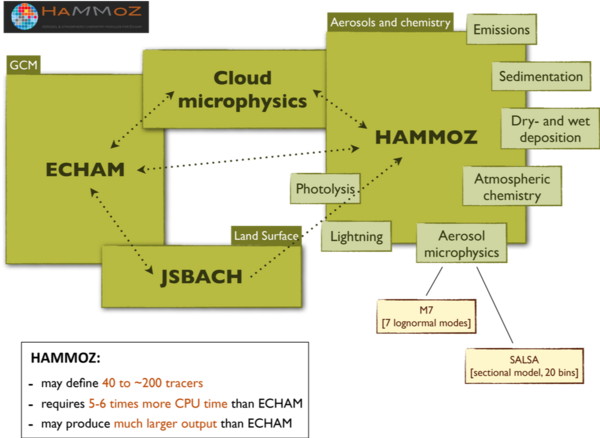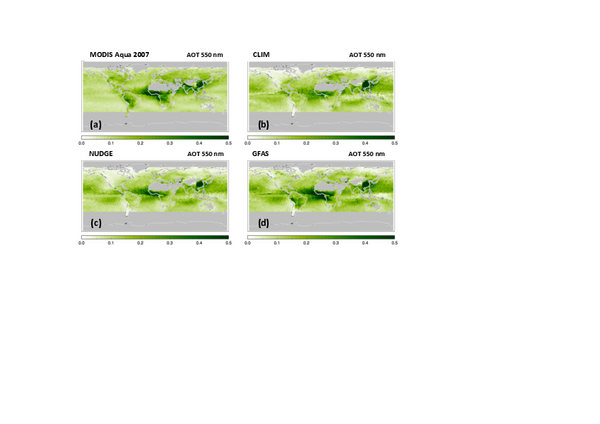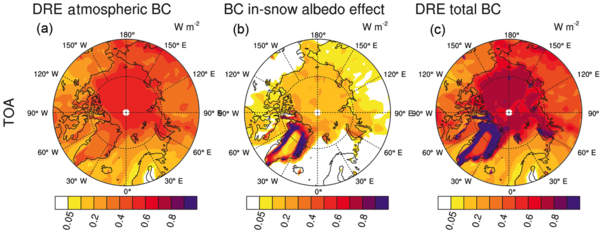

The Hamburg Aerosol Module (HAM) and the atmospheric chemistry code MOZART (MOZ) provide a detailed representation of tropospheric-stratospheric chemistry and include state-of-the-art parameterizations of aerosols using either a modal (M7) or a bin scheme (SALSA). Coupled to the general atmospheric circulation model ECHAM, they form the aerosol chemistry-climate model ECHAM-HAMMOZ. There is also a coupled version with the Earth system model MPI-ESM; the coupling with the new atmospheric climate model ICON-A could be realized recently and tested in a first evaluation study.

The aerosol model HAM calculates the dispersion and evolution of the mass and number concentrations of an aerosol mixture considering the species sulphate, black carbon (BC), organic carbon (OC), sea salt and mineral dust. The aerosol optical thickness calculated from the computed aerosol distributions is shown for some model configurations in Fig. 2.

Fig. 2: Comparison of average annual aerosol optical thickness (AOT) from measurements by the MODIS-Aqua satellite instrument (a) and from different model studies for the year 2007 (from: Tegen et al., 2019, https://doi.org/10.5194/gmd-12-1643-2019).
The effects of aerosols on clouds and radiation are prognostically calculated in the coupled model ECHAM-HAM (an example is shown in Fig. 3).

Fig. 3: Multi-year mean direct aerosol radiation effect (DRE) at the BC atmospheric upper boundary for the period 2005-2009, for the effect of atmospheric BC (a), the effect on snow albedo (b), and the combined effect (c). From Schacht et al (2019), https://doi.org/10.5194/acp-19-11159-2019
The standard version of HAM describes the aerosol size spectrum through the modal M7 aerosol model, which simulates a superposition of seven lognormal modes: Nucleation mode, Soluble (mixed) and Insoluble Aitken, Accumulation and Coarse modes. Each aerosol mode is assumed to be internally mixed, so that individual particles in a mode can be mixtures of different species. Insoluble particles can become mixed (soluble) by condensation of soluble substances and by collisions with mixed particles. The HAM2.3 emission module for primary aerosol particles and gas phase compounds is designed to provide emissions for individual sectors such as industrial or domestic fossil fuel use in a user-friendly way.
The scientific and technical development of the HAMMOZ code is carried out within a consortium in cooperation with partners from several European universities and research institutes. After many years of coordinating HAMMOZ development at ETH Zurich, this task has now been taken over by TROPOS. The model code is subject to version control and is maintained. TROPOS is responsible for user support and the administration of the ICON-HAM input data. HAMMOZ users have access to extensive technical and scientific documentation, scripts, and input data sets. ECHAM-HAMMOZ has been ported to various HPC platforms (e.g. DKRZ: Mistral, FZJ/FSC: Jureca) where it has proven to be powerful and well scalable. From a scientific point of view, participation in international model comparison initiatives (AerChemMIP, AeroCom) and more than 90 journal articles over the last 15 years impressively demonstrate the success of HAMMOZ.
